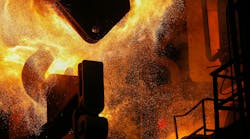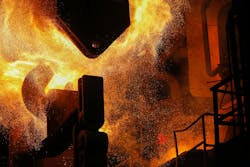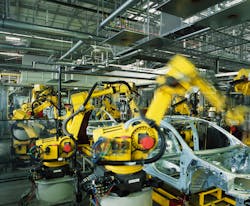Sensors designed to support the production of metals and manufacturing metal components are in a unique category because they require years of practical experience in the metals industry and in-depth knowledge of engineering and metallurgy. Best-in-class sensor systems for metallurgical applications often involve cameras that make processing and production environments safer, more efficient and environmentally sustainable.
For a deeper dive into this topic, we will reference the EVCam6, an industrial high-temperature infrared (IR) vision system comprised of hardware and software. While there are many IR cameras on the market for livestreaming, few are paired with customized software. Without software, it would be impossible to track, analyze and store the images captured by the camera.
Sensor systems designed for extreme industrial conditions, where high temperatures are the norm, require rugged design and housing that can be easily handled and safely cooled. The EVCam6 is manufactured with patented cooling technology that can be either air- or water-based depending on the operating environment. The air-cooled method involves a near-supersonic flow of industrial gas that creates an almost impenetrable barrier to protect the camera optics, keeping them protected from thermal radiation and clean from the debris that could damage standard cameras used in the same environment.
We will examine how steelmakers, copper and titanium producers and robotics operations can use and benefit from metallurgical sensors.
Steelmaking
The melting process within a steel mill is one of the harshest industrial events. Although the process is contained within closed vessels, it involves toxic additives in average temperatures of 2,912°F (1,600°C). These conditions make direct visual observation of the moving matter inside the smelter humanly impossible. However, with the invention of extreme vision cameras manufactured to withstand the heat, steelmakers can now reliably manage their furnaces and smelters by seeing precisely what is happening inside. From a safe distance, production crews can watch what happens as oxidizing or reducing agents are introduced into the steelmaking vessels and make accurate adjustments to achieve the desired results.
During the steelmaking process, sensor systems are exposed to furnaces that often run continuously for weeks or months. Over time, the structures surrounding the furnace become heat soaked, defined by temperatures up to 575°F (300°C), which is hazardous to workers. Protective cooling technology removes this hazard, promoting safety. Advance visualization technology eliminates the guesswork of the past, enable workers to react rapidly to changing situations that they can see inside the smelter, also eliminating unnecessary downtime.
READ MORE: 5 Reasons Metallurgy is Essential in Material Selection for Harsh Environments
Downtime in the steel mill can cost thousands of dollars per hour, making every second matter. Owing to the use of advanced vision systems, shaving 15 sec. from a critical process combined with not having to slow down or stop the machines can save a steel producer hundreds of thousands of dollars a month. This enables the realization of significant production increases, demonstrating one of several potential production efficiencies. The possibilities are endless depending on the operator’s situation and the customized solution engineered by the sensor system provider to meet a defined set of key performance objectives.
One solution might involve identifying regions of heat zones within the ladle operation and building an interface into the sensor system configuration that allows the operator to click on a specified temperature zone for a zoomed-in view; the data can then be tracked, stored and analyzed. The camera can be tied into the steelmaker’s level 2 system to monitor the ladle in the heat zones. The software detects the heat zones, processes real-time data and compares any historical data available for highly informative analytics that can be leveraged for immediate and future improvements.
Copper and Titanium Production
Copper production is like steelmaking when it comes to heat, but copper has lower melting point temperatures. Nevertheless, a camera designed for temperatures up to 930°F (500°C) is still required. Based on the environment, the cooling technology must be adjusted to ensure that that there is enough pressure and volume of clean air, or what is known as dirty air, running through the camera to keep it from succumbing to the heat.
Many producers have a keen interest in seeing the melt zone of their materials, so it is important to confirm whether the camera system under consideration can survive inside or outside the furnace. With both manual and digital zoom capabilities, the EVCam6 can provide real-time melt zone imagery and data from both vantage points. A copper producer may benefit from this, but must also consider having as many external exhaust ports on the camera as possible for cooling and for a higher density debris shield. Artificial Intelligence can be built into the software of the system and applied to collect edge detection data about the moving lances to identify additional opportunities for efficiencies.
Titanium is sometimes processed at a higher temperature than steel, and what differentiates the two melt processes is how and where the melt occurs. There are different types of furnaces, and in each furnace the cameras for the sensor systems are introduced from a different entry point, or physical direction. In an electric arc furnace, for example, cameras are installed from the top of the furnace, where the electricity runs through it, and pushed down into the melt. The operator uses an endoscope to lower the camera into the furnace for a downward view. Other furnaces used in copper and steel production are designed with burners on the sides, so the cameras are installed inside on the sides of the refractory walls for observation.
No matter what direction provides the optimal view, the cameras in the EVCam6 can be adjusted to viewing angles from anywhere from 60 deg. to about 180 deg. depending on the situation. The higher the temperature, the more challenging it becomes because sufficient airflow is necessary to keep the camera from melting. The standard industrial camera is rated to a maximum temperature tolerance of 140°F (60°C), so when placed into a furnace above 1,472°F (800°C), without proper air flow, the camera will melt instantaneously. This is the reason standard cameras are never placed directly into the melt zone in the refractory wall. However, the EVCam6 was designed to survive in this environment.
Robotics Operations
Although robotics operations are quite different from metals production, they share the benefits of the efficiencies that sensor systems can identify. Oftentimes when robotics are discussed, the question of replacing people arises because most industrial robots are used primarily to do the heavy lifting and repetitive tasks that were previously performed by humans. With the emergence of Industry 5.0, robotic functions are being combined with human tasks to improve the workplace in ways unimaginable before.
Take for example visually inspecting critical machinery components such as bearings and fasteners. When they begin to wear and fail, advanced sensor systems enable operators to take their preventative maintenance programs to the next level. Sensors enable predictive analysis of data collected either visually with cameras or through vibrations detected when accelerometers are installed on robotics. Having the data on hand to justify replacing components ahead of routine maintenance due to predictive failure can be a game changer.
Specific Experience in Metallurgy
When evaluating sensor systems for metallurgical and robotic operating systems, look for a solution that offers a complete system that includes hardware and software. Partner with a sensor solutions provider with expertise in engineering and metallurgy and value-added services, such as continued training for plant employees and a remote monitoring management system.
This article was submitted by Shiva Bissoon, COO and VP of Sales & Business Development, Metallurgical Sensors Inc.



